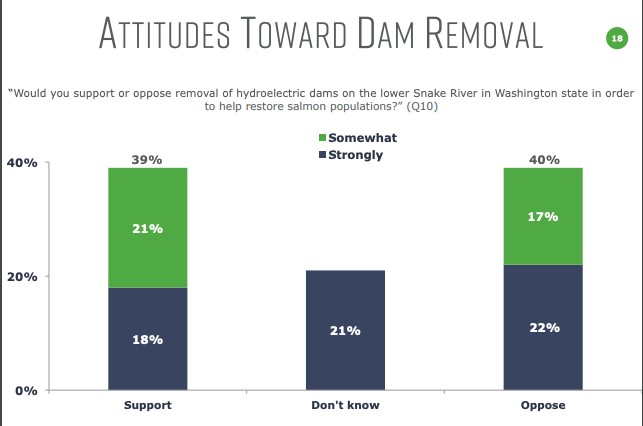forum
library
tutorial
contact

Washington Policy Center Releases Results of
Statewide Poll on Snake River Dams
by Carissa Lehmkuhl
Yakima Herald, December 17, 2019
|
the film forum library tutorial contact |

|
Washington Policy Center Releases Results of
by Carissa Lehmkuhl
|
"What we found is they (survey respondents) don't know very much and in fact, some of what they know is simply wrong.
Many people thought that the population of salmon on the Snake was declining, an in fact (?) it's actually increasing."
 KENNEWICK, Wash. -- Results of a statewide poll released on Tuesday shed light on what Washingtonians think about the lower Snake River dams and how much they really know.
KENNEWICK, Wash. -- Results of a statewide poll released on Tuesday shed light on what Washingtonians think about the lower Snake River dams and how much they really know.
The Washington Policy Center, a public policy research organization, surveyed 500 Washingtonians in November for the results.
One takeaway of the poll -- some in Washington appear to have inaccurate or incomplete perceptions of the lower Snake River dams.
WPC's polling results showed that 93 percent of Washingtonians surveyed didn't know how many dams were on the lower Snake River. Only 5 percent of those polled knew that salmon populations on the lower Snake River have been increasing in recent years.
"The more Washingtonians know, the more they want to keep the Snake River dams," said Chris Cargill, Eastern Washington director at the Washington Policy Center.
This comes as the future of the Snake River dams is in limbo. Those in support of the dams say they provide a host of benefits including hydropower and irrigation, while others want to remove the dams to increase salmon and orca numbers and allow for a free--flowing river.
 "People think salmon populations are declining when they're actually increasing, and people don't know how important the Snake River dams are," said Todd Myers, director of the Center for the Environment at the Washington Policy Center. "They produce as much electricity as all of the wind and solar in Washington state combined.
"People think salmon populations are declining when they're actually increasing, and people don't know how important the Snake River dams are," said Todd Myers, director of the Center for the Environment at the Washington Policy Center. "They produce as much electricity as all of the wind and solar in Washington state combined.
Myers and Cargill were joined by State Senator Sharon Brown at the unveiling of the poll results in Kennewick. Brown said one of her top priorities as a member of the legislature representing the Tri--Cities area is affordable energy and realizing the importance of the energy sector for the local economy. She touted the Columbia and Snake rivers as valuable resources for the region.
"It is so odd that with this backdrop we find hydroelectric dams under increasing criticism," said Sen. Brown. "Breaching our dams would be a serious mistake."
In addition to his role at the Washington Policy Center, Myers is also part of the Puget Sound Salmon Recovery Council. He said the energy and money spent on salmon recovery needs to be directed at the Puget Sound region rather than the Snake River.
"We don't see the population increasing there in the same way that we've seen it increase on the Snake over the last 20 years," he said. "I think we need to focus our efforts where it's going to make the biggest difference, which is the Puget Sound -- not the Snake."
Myers said roughly $50 million has already been spent on helping salmon survival rates in the Puget Sound area, while tearing down the lower Snake River dams would cost an estimated $1 billion at least, and the consequences of that happening are unknown.
"You're basically rolling the dice on one thing and hoping it works," said Myers.
In the WPC poll, respondents were also asked if they would be willing to pay more for their electricity in order to remove the dams and help salmon. 33 percent said they would, and 60 percent said no. When respondents were asked if they would be willing to pay more for fish passage at the dams, 65 percent said yes, and 28 percent said no.
"To help salmon, the key question is where should we put the money to get the most environmental benefit," said Myers.
Myers said the goal of releasing the results is to inform both lawmakers and residents of Washington, in hopes of properly prioritizing funding for salmon and orca recovery.
In May, Governer Inslee signed a bill to allocate $750,000 in state funding toward studying what would happen if the Snake River dams were breached. The results of that study are expected to be released on Friday.
For the full poll results, click here.
Related Pages:
It's Not Even Close: Economics says the Snake River Dams Should Go by Daniel Malarkey, Sightline Institute, 9/16/19
learn more on topics covered in the film
see the video
read the script
learn the songs
discussion forum
